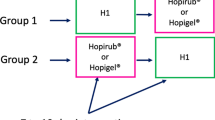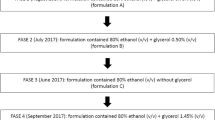Abstract
Background and aims
Ethanol- or 2-propanol-containing disinfectant agents are widely used in medical practice, particularly in the surgical environment. It was the primary objective of this phase I study to comparatively investigate the transdermal resorption of ethanol and 2-propanol within 1 h after dermal application of the two agents as single preparations and a commercial product containing both alcohols in combination, respectively. The secondary objective was to examine whether a mutual influence of the two alcohols in combination exists.
Materials and methods
Following the double-blind, randomized, three-times cross-over design for this clinical trial, 20 ml of three different alcohol-containing disinfectants were applied on a 200-cm2 gauze swab on skin areas, identical in size and location, of 14 healthy volunteers for 10 min to investigate the absorption rate of ethanol and 2-propanol with special focus on the question whether the two alcohols might influence each other’s absorption rate when being applied in combination.
Results
No clinically relevant enhancement of dermal absorption, with respect to ethanol and 2-propanol, could be observed within 1 h after application, neither when used as single preparations, nor in combination.
Conclusion
Therefore, the use of ethanol- and 2-propanol-containing disinfectants in the medical environment can be considered as safe.



Similar content being viewed by others
References
Hartmann AA, Hornschuh B (1991) The vertical penetration of alcoholic skin disinfectants into the human skin. Z Heereskd 67(4):316–322
Pendlington RU, Whittle E, Robinson JA, Howes D (2001) Fate of ethanol topically applied to skin. Food Chem Toxicol 39:169–174
Ritschel WA, Hussain AS (1988) The principles of permeation of substances across the skin. Methods Find Exp Clin Pharmacol 10(1):39–56
Scheuplein RJ, Blank IH (1973) Mechanisms in percutaneous absorption. IV. Penetration of non-electrolytes (alcohols) from aqueous solutions and from pure liquids. J Invest Dermatol 60(5):286–296
Turner P, Saeed B, Kelsey MC (2004) Dermal absorption of isopropyl alcohol from a commercial hand rub: implications for its use in hand decontamination. J Hosp Infect 56:287–290
International Guidelines of AWMF-registration N° 076/001 (2003) Acute treatment of alcohol use disorders. Sucht 49(3):147–167
Boatman RJ, Perry LG, Fiorica LA (1998) Dermal absorption and pharmacokinetics of isopropanol in the male and female F-344 rat. Drug Metab Dispos 26(3):197–202
Martinez TT, Jaeger RW, deCastro FJ, Thompson MW, Hamilton MF (1986) A comparison of the absorption and metabolism of isopropyl alcohol by oral, dermal and inhalation routes. Vet Hum Toxicol 28(3):233–236
Peschel O, Bauer MF, Gilg T, v Meyer L (1992) Alterations of congener analysis by percutaneous absorption of propanol containing antiseptics. Blutalkohol 29:172–184
Borneff M, Hingst V, Sonntag HG (2003) Recommendations of the University of Heidelberg. Hygiene recommendations, Heidelberg
List of disinfection procedures according to the Guidelines for Testing Chemical Disinfectants and found effective by the DGHM, Bonn (2000) Disinfections Committee of the German Society for Hygiene and Microbiology (DGHM). Guidelines for testing chemical disinfectants. mhp-Verlag GmbH, Wiesbaden
Peek GJ, Marsh A, Keating J, Ward RJ, Peters TJ (1990) The effects of swabbing the skin on apparent blood ethanol concentration. Alcohol Alcohol 25(6):639–640
Vievier PM, Lewander WJ, Martin HF, Linakis JG (1994) Isopropyl alcohol intoxication in a neonate through chronic dermal exposure: a complication of a culturally-based umbilical care practice. Pediatr Emerg Care 10(2):91–93
Leeper SC, Almatari AL, Ingram JD, Ferslew KE (2000) Topical absorption of isopropyl alcohol induced cardiac and neurologic deficits in an adult female with intact skin. Vet Hum Toxicol 42(1):15–17
Rajabally YA, Mortimer NJ (2004) Acute neuropathy and erythromelalgia following topical exposure to isopropanol. Vet Hum Toxicol 46(1):24–25
Dyer S, Mycyk MB, Ahrens WR, Zell-Kanter M (2002) Hemorrhagic gastritis from topical isopropanol exposure. Ann Pharmacother 36(11):1733–1735
Author information
Authors and Affiliations
Corresponding author
Rights and permissions
About this article
Cite this article
Kirschner, M.H., Lang, R.A., Breuer, B. et al. Transdermal resorption of an ethanol- and 2-propanol-containing skin disinfectant. Langenbecks Arch Surg 394, 151–157 (2009). https://doi.org/10.1007/s00423-007-0237-7
Received:
Accepted:
Published:
Issue Date:
DOI: https://doi.org/10.1007/s00423-007-0237-7




